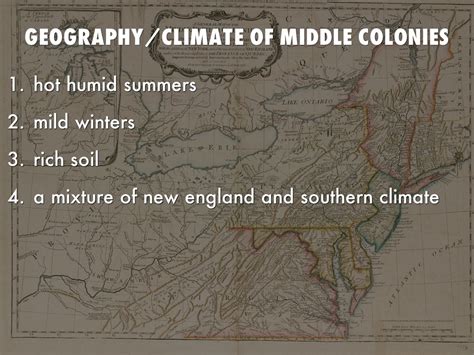The Middle Colonies, consisting of New York, New Jersey, Pennsylvania, and Delaware, boast a humid subtropical climate that contributes to their diverse ecosystems and agricultural productivity.

Temperature Patterns
The Middle Colonies experience warm, humid summers and chilly, often snowy winters.
Summer Temperatures: Average summer temperatures range from 70°F (21°C) in coastal areas to 75°F (24°C) inland. The hottest months are July and August, with occasional heat waves pushing temperatures into the 90s or even 100s.
Winter Temperatures: Average winter temperatures range from 25°F (-4°C) in the north to 35°F (2°C) in the south. Winter storms often bring snowfall, with coastal areas receiving an average of 12-24 inches (30-60 cm) annually and inland areas receiving up to 36 inches (90 cm).
Precipitation Patterns
The Middle Colonies receive ample precipitation throughout the year.
Rainfall: The region’s average annual rainfall ranges from 35-45 inches (89-114 cm), with coastal areas receiving slightly more than inland areas. Precipitation is spread relatively evenly throughout the year, with occasional droughts or heavy downpours.
Snowfall: Coastal areas receive moderate snowfall, while inland areas can experience significant snowfall during winter months. The mountains in the western part of the region, such as the Catskills and Poconos, receive the most snow, with some areas receiving over 100 inches (254 cm) per year.
Humidity Levels
The Middle Colonies experience high humidity levels, especially during the summer months. The proximity to the Atlantic Ocean and the Gulf Stream contribute to the region’s humid atmosphere.
Summer Humidity: Summer humidity levels can reach up to 80% or higher, making it feel even hotter than the actual temperature. This humidity can be uncomfortable for some individuals and can lead to heat-related illnesses.
Winter Humidity: Winter humidity levels are typically lower than in summer, ranging from 50-60%. The cold temperatures and lack of precipitation contribute to the drier air.
Impact on Vegetation
The climate of the Middle Colonies supports a wide range of plant life.
Forests: The region is home to a mix of deciduous and coniferous forests. Deciduous trees, such as oaks and maples, dominate in the southern and coastal areas, while coniferous trees, such as pines and firs, are more common in the northern and mountainous areas.
Grasslands: Open grasslands and meadows are found in some parts of the region, especially in the Great Plains area of western Pennsylvania.
Wetlands: Coastal areas and river basins are home to various wetlands, including marshes, swamps, and bogs. These wetlands provide important habitats for birds, fish, and other wildlife.
Impact on Agriculture
The climate of the Middle Colonies is favorable for agriculture.
Growing Season: The long growing season, which lasts for approximately 180-200 days, allows farmers to grow a variety of crops.
Fertile Soils: The soils in the Middle Colonies are generally fertile and well-drained, thanks to the region’s mixed geology and glaciation.
Diversity of Crops: The region’s humid climate and varied topography support a wide range of crops, including corn, soybeans, wheat, fruits, and vegetables.
Climate Change Impacts
The climate of the Middle Colonies is already being affected by climate change, and these impacts are expected to increase in the future.
Rising Temperatures: The region is experiencing a gradual increase in temperatures, with more frequent and intense heat waves.
Increased Precipitation: The Middle Colonies are seeing more frequent and heavier rainfall events, which can lead to flooding and erosion.
Coastal Impacts: Coastal areas are vulnerable to sea-level rise and storm surges, which can damage infrastructure and disrupt communities.
Adaptation and Mitigation Strategies
To address the impacts of climate change, the Middle Colonies are implementing various adaptation and mitigation strategies.
Adaptation:
* Building seawalls and levees to protect coastal areas from flooding
* Developing heat-response plans to minimize the effects of extreme heat
* Promoting drought-resistant plants and crops
Mitigation:
* Reducing greenhouse gas emissions by investing in renewable energy sources and energy efficiency measures
* Planting trees and preserving forests to absorb carbon dioxide
* Supporting sustainable agriculture practices to reduce emissions
Conclusion
The climate of the Middle Colonies provides a favorable environment for human settlement and economic activity. However, the region is also facing challenges due to climate change. By implementing adaptation and mitigation strategies, the Middle Colonies can address these challenges and ensure a sustainable future for its residents.
Q: What is the average temperature in the Middle Colonies during the summer?
A: The average summer temperature ranges from 70°F (21°C) in coastal areas to 75°F (24°C) inland.
Q: How much snowfall do the coastal areas of the Middle Colonies receive annually?
A: Coastal areas receive an average of 12-24 inches (30-60 cm) of snowfall per year.
Q: What type of vegetation is common in the Middle Colonies?
A: The region is home to a mix of deciduous and coniferous forests, as well as grasslands and wetlands.
Q: How does climate change impact the Middle Colonies?
A: Climate change is leading to rising temperatures, increased precipitation, and coastal impacts, including sea-level rise and storm surges.
Q: What adaptation strategies are being implemented to address climate change in the Middle Colonies?
A: Adaptation strategies include building seawalls and levees, developing heat-response plans, and promoting drought-resistant plants and crops.
Q: How can the Middle Colonies mitigate climate change?
A: Mitigation strategies include reducing greenhouse gas emissions by investing in renewable energy sources and energy efficiency measures, planting trees, and supporting sustainable agriculture practices.
Q: Is climate change a threat to the economy of the Middle Colonies?
A: Climate change poses a significant threat to the economy of the Middle Colonies, particularly industries such as agriculture, tourism, and fisheries.
Q: What can individuals do to help address climate change in the Middle Colonies?
A: Individuals can reduce their carbon footprint by adopting sustainable practices, such as reducing energy consumption, driving less, and supporting businesses that prioritize environmental sustainability.
